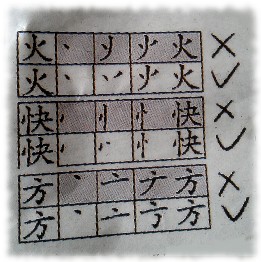10 hanzi you thought you knew how to write correctly
 There was a small piece in one of the Qingdao newspapers the other day about Chinese characters that are commonly written with incorrect stroke orders. I can’t remember which paper now, unfortunately, but I’ve listed the characters and their correct stroke orders here.
There was a small piece in one of the Qingdao newspapers the other day about Chinese characters that are commonly written with incorrect stroke orders. I can’t remember which paper now, unfortunately, but I’ve listed the characters and their correct stroke orders here.
The article was aimed at Chinese readers, not foreign learners, so it was interesting to see what native speakers consider correct and incorrect.
1. 方 (fāng)
How most people write it:
How it should be written:
Yep, that ㇆ stroke comes before the 丿. The 丿stroke is called 撇 (‘slant’), and the ㇆ stroke is called 横折钩 (‘right angle hook’). The right angle hook should be written before the slant, despite most people doing it the other way round.
2. 万 (wàn)
It actually stems from the way in which 万 should be written. Characters with this as a component are frequently written in the wrong order:

Again, you should write the ㇆ before the 丿, like this:
Why? I don’t know, but that’s the stroke order that character nerds will give you. I’m tempted to think that this is somewhat equivalent of the split infinitives rule in English (a ridiculous rule that a lot of people promote without any good reason).
3. 火 (huǒ)
I was actually writing this one correctly before I saw the article (thanks to Skritter, I think), but apparently a lot of people write 火 in this order:
The correct order is in fact:
The strokes in 火 are 丶 ㇒ 丿㇏, called 点, 提, 竖撇 and 捺 respectively. They should be written in that order as well!
4. 车 (chē)
There seems to be [some debate](http://zhidao.baidu.com/question/42527621 "” 车 " 的 笔顺 ? 百度知道”) about the correct stroke order for 车, but according to the newspaper article you don’t write it like this:
The correct order is in fact:
The article also pointed out another common mistake involving 车. Play spot the difference with these two versions of 轻:
When 车 appears as a radical in other characters (e.g. 转, 较, 载), the final 一 stroke actually turns into a ㇀. As far as I know this upward slant is purely aesthetic, and just helps to balance the character; you might be able to improve your handwriting a little if you pay attention to this!
5. 里 (lǐ)
This one really surprised me, and I still can’t get used to it. I always thought that 里 was written in this order:

You’re actually supposed to write 甲 first then just add two lines, like this:
It’s 丨㇕一一丨一一, not 丨㇕一一一丨一.
6. 快 (kuài)
Another one that I didn’t know, although this one does seem natural with the correct stroke order. Previously I’d been writing 快 like this:
The 忄 radical is actually written in a different order:
This applies to any character containing the 忄 radical, of course: 情, 性, 怀 etc. The order is ㇒丶丨㇕一丿㇏, not ㇒丨丶㇕一㇓㇏.
7. 母 (mǔ)
This one isn’t so much stroke order as the number of strokes. Apparently some people write 母 like this, although I’ve never seen anyone do it:

There’s one more stroke than there should be. The first stroke of 母 is actually ㇄, making five strokes in total:
8. 及 (jí)
This one is a common variant, but strictly speaking it’s wrong:
You’re supposed to write the 丿 stroke first, like this:
So the correct order is 丿㇋㇏. The same thing applies for similar looking characters, like 九, which should be 丿 then ㇈.
9. 义 (yì)
There are definitely a lot of people that write 义 in the ‘wrong’ order, as the technically correct one does seem a little strange. First up, the incorrect stroke order:
It’s actually supposed to be written like this, though:
The dot (丶) should be written first, followed by the criss-crossing strokes.
10. 爽 (shuǎng)
And finally, a slightly less common character that often gets written in the wrong order. It’s tempting to write 爽 like this:
(I’ve grouped the repeated ㇒丶 strokes together to keep it clear.) Even nciku gives this stroke order. But according to the newspaper article, 爽 should actually be written like this:
This stroke order is more consistent with that of traditional 來, for example, and is the one used on Skritter. This is obviously a highly debatable topic, though, as no-one really has the authority to say which stroke order is wrong and which is right.
Did you already have all these pinned down, or were there some surprises? Do you disagree with the ‘correct’ stroke orders given here? Please share all in the comments!


















